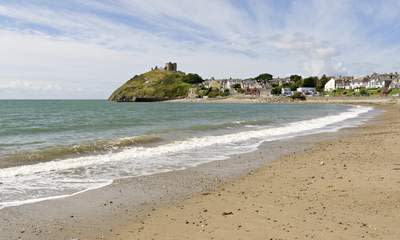Earthquake Shakes Homes In North Wales
The British Geological Survey has reported that a 3.8 magnitude earthquake has rattled the Llyn Peninsula in North Wales.
The epicentre is being reported to be near Tudweiliog, about six miles west of Pwllheli, in Gwynedd.
It occurred at 4.16am, just off the coast, at a depth of 8km.
Shaking of buildings was reported as far away as Counties Carlow, Kildare and Wicklow in Ireland.
In Britain, the tremor was felt in many communities in North Wales and even in Douglas, Isle of Man and Southport, Merseyside.
The British Geological Survey, which maps earthquakes from the UK, said around 180 people had reported feeling the earthquake, but the majority were within a 30 to 45mile (50 to 75km) radius.
Peter Wilkinson, owner of the Penrallt Coastal Campsite, about a mile from the epicentre, said he was woken by what felt like a thud and thought that the corner of his house had fallen off.
He said about 30 families were staying on the campsite and described feeling the earth 'moving around'.
"The earth certainly moved for us," he said. "I woke with a start and thought that the corner of the house had fallen off.
"I got up to see if something had fallen over in the room and went to check all of the rooms, but there wasn't any sign.
"I would describe it as like hearing a large thud - like a wardrobe falling over.
"But the others in the campsite have been talking about it a lot more. They said it felt like the earth was moving around and was really quite scary.
"It's really been the talk of the campsite this morning."
The Llyn Peninsula was hit by a quake in 1984 measuring 5.4 - the largest on-shore earthquake in the UK since seismological records began.
Initial reports of the quake varied, with organisations like the European-Mediterranean Seismological Centre rating the quake at 4.3.
That organisation, based near Paris, put the epicentre much further out to sea - about a third of the way between Wales and Ireland. They later downgraded it to a 4.0.
Dr Roger Musson, of the British Geological Survey, said: "It's not something that's likely to cause structural damage or have a severe impact.
"This is the most seismic place in the UK and over history there have been a long series of earthquakes in this part of North Wales.
"So it's not very surprising that we should have this earthquake this morning.
"The one thing that is interesting from a seismological point of view is that this earthquake is further to the south west, along the coast of the Lynn Peninsula, than other earthquakes than we've had in this area.
"You would expect it to be felt in the east coast of Ireland. It's possible that we will get small aftershocks but I wouldn't expect them to be that large."
The Irish National Seismic Network (INSN) said tremors were felt in counties in south-east Ireland and its seismic stations in Valentia off the south-west coast, Donegal and Galway all recorded the earthquake.
Tom Blake, INSN director, said there has been a significant increase in seismic activity in the area in recent months.
The last significant earthquake in the UK occurred at Market Rasen in Lincolnshire in February 2008, which was a magnitude 5.2.

 Yahoo News
Yahoo News 

